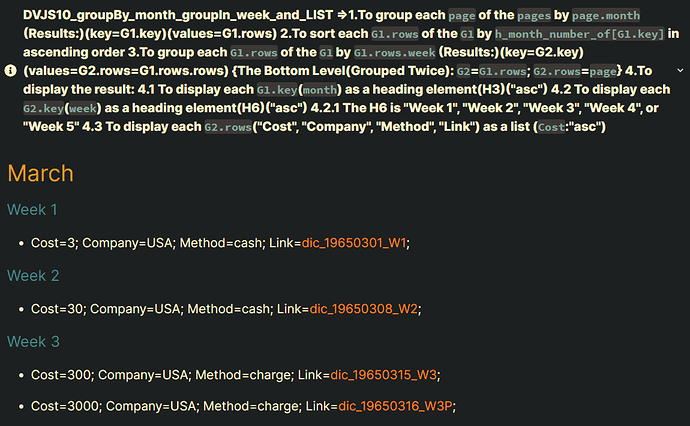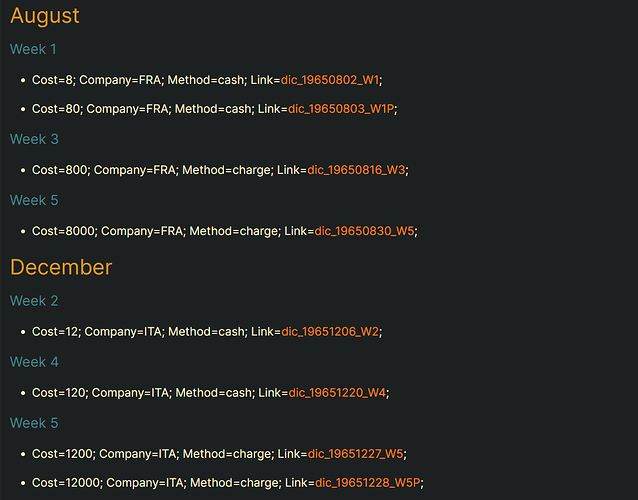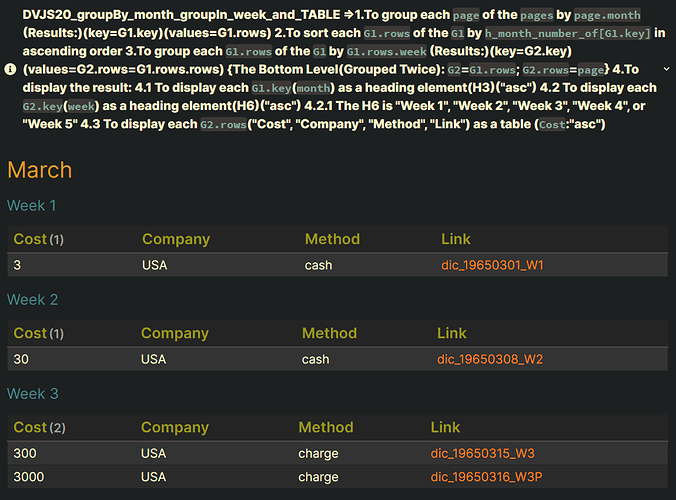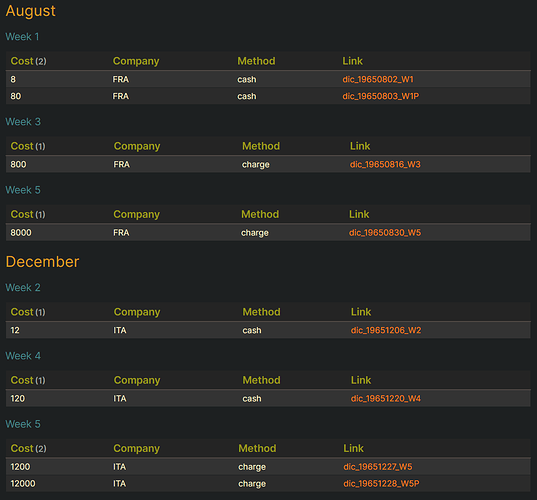Topic
Summary
- How to group the data by
monthand group the grouped data byweekin either dataview or dataviewjs?
Test
Summary
- dataview: v0.5.46
Input
Summary
dictionary files:
- Location: “100_Project/01_dataviewjs/01_by_example/Q29_GroupIn/Q29_test_data”
folder: R03
- filename :
dic_19650301_W1
---
Date: 1965-03-01
---
#Project/P03
month:: "March"
week:: 1
Cost:: 3
Company:: "USA"
Method:: "cash"
Type::
Desc::
- filename :
dic_19650308_W2
---
Date: 1965-03-08
---
#Project/P03
month:: "March"
week:: 2
Cost:: 30
Company:: "USA"
Method:: "cash"
Type::
Desc::
- filename :
dic_19650315_W3
---
Date: 1965-03-15
---
#Project/P03
month:: "March"
week:: 3
Cost:: 300
Company:: "USA"
Method:: "charge"
Type::
Desc::
- filename :
dic_19650316_W3P
---
Date: 1965-03-16
---
#Project/P03
month:: "March"
week:: 3
Cost:: 3000
Company:: "USA"
Method:: "charge"
Type::
Desc::
folder: A08
- filename :
dic_19650802_W1
---
Date: 1965-08-02
---
#Project/P08
month:: "August"
week:: 1
Cost:: 8
Company:: "FRA"
Method:: "cash"
Type::
Desc::
- filename :
dic_19650803_W1P
---
Date: 1965-08-03
---
#Project/P08
month:: "August"
week:: 1
Cost:: 80
Company:: "FRA"
Method:: "cash"
Type::
Desc::
- filename :
dic_19650816_W3
---
Date: 1965-08-16
---
#Project/P08
month:: "August"
week:: 3
Cost:: 800
Company:: "FRA"
Method:: "charge"
Type::
Desc::
- filename :
dic_19650830_W5
---
Date: 1965-08-30
---
#Project/P08
month:: "August"
week:: 5
Cost:: 8000
Company:: "FRA"
Method:: "charge"
Type::
Desc::
folder: D12
- filename :
dic_19651206_W2
---
Date: 1965-12-06
---
#Project/P12
month:: "December"
week:: 2
Cost:: 12
Company:: "ITA"
Method:: "cash"
Type::
Desc::
- filename :
dic_19651220_W4
---
Date: 1965-12-20
---
#Project/P12
month:: "December"
week:: 4
Cost:: 120
Company:: "ITA"
Method:: "cash"
Type::
Desc::
- filename :
dic_19651227_W5
---
Date: 1965-12-27
---
#Project/P12
month:: "December"
week:: 5
Cost:: 1200
Company:: "ITA"
Method:: "charge"
Type::
Desc::
- filename :
dic_19651228_W5P
---
Date: 1965-12-28
---
#Project/P12
month:: "December"
week:: 5
Cost:: 12000
Company:: "ITA"
Method:: "charge"
Type::
Desc::
DVJS10_groupBy_month_groupIn_week_and_LIST
Summary
Main DVJS
| Code Name | Data type | Group By | Purposes | Remark |
|---|---|---|---|---|
| DVJS10 _groupBy_month _groupIn_week _and_LIST |
month:a string like “January”, “February” , …, or “December” week:a number like 1, 2, 3, 4 or 5 |
yes (twice) |
1.To group each page of the pages by page.month (Results:)(key=G1.key)(values=G1.rows) 2.To sort each G1.rows of the G1 by h_month_number_of[G1.key] in ascending order 3.To group each G1.rows of the G1 by G1.rows.week (Results:)(key=G2.key)(values=G2.rows=G1.rows.rows) {The Bottom Level(Grouped Twice): G2=G1.rows; G2.rows=page} 4.To display the result: 4.1 To display each G1.key(month) as a heading element(H3)(“asc”) 4.2 To display each G2.key(week) as a heading element(H6)(“asc”) 4.2.1 The H6 is “Week 1”, “Week 2”, “Week 3”, “Week 4”, or “Week 5” 4.3 To display each G2.rows(“Cost”, “Company”, “Method”, “Link”) as a list (Cost:“asc”) |
1.The DVJS10 is based on the DVJS20_A2_21 in the following topic. - Solutions: by Justdoitcc |
Notes:
Summary
Q1: How to sort the groups by G1.key(month)(H3) in custom order? (DVJS10:M13+M21)
Summary_Q1
A1_11:
Original Example: A1_11
```dataviewjs
// M13. define h_month_number_of:
// Features: To transform a month into a number
// Purposes: To sort the `month` field in custom order
// h_month_number_of["March"] = 3
// h_month_number_of["August"] = 8
// h_month_number_of["December"] = 12
// #####################################################################
let h_month_number_of = {
January: 1,
February: 2,
March: 3,
April: 4,
May: 5,
June: 6,
July: 7,
August: 8,
September: 9,
October: 10,
November: 11,
December: 12,
};
// M21. define groups:
// groupBy_CASE:To group each `page` of the `pages` by `page.month`
// (Results:)(key=G1.key)(values=G1.rows)
//
// Each `G1.key` is a value from the `page.month`.
// Each `G1.rows` is an Array of JavaScript Objects.
//
// sort_CASE:To sort each `G1.rows` of the `G1` by `h_month_number_of[G1.key]` in ascending order
//
// groupIn_CASE:To group each `G1.rows` of the `G1` by `G1.rows.week`
// (Results:)(key=G2.key)(values=G2.rows=G1.rows.rows)
//
// Each `G2.key` is a value from the `G1.rows.week`.
// Each `G2.rows` is an Array of JavaScript Objects.
//
// The Bottom Level(Grouped Twice): `G2`=`G1.rows`; `G2.rows`=`page`
// #####################################################################
let groups = pages
.groupBy((page) => page.month) // groupBy: (default) in ascending order
.sort((G1) => h_month_number_of[G1.key], "asc")
.groupIn((G1) => G1.week); // groupIn: (default) in ascending order
```
Q2: How to sort each G1.rows by G2.key(week)(H6) in descending order? (DVJS10:M31.FR12)
Summary_Q2
A2_21:
Original Example:
```dataviewjs
// M31. output groups:
// #####################################################################
for (let G1 of groups) {
// M31.FR10 output G1.key: H3
// G1.key: the value of the `month` field
// Q29_GroupIn_CASE: "March", "August", "December"
// #####################################################################
dv.header(3, G1.key);
// M31.FR12 sort G1.rows: in descending order
// G1.rows.key: the value of the `week` field
// Q29_GroupIn_CASE: "1", "2", "3", "4", "5"
// G2.key=G1.rows.key
// #####################################################################
G1.rows = G1.rows.sort((G2) => G2.key, "desc");
}
```
Q3: How to sort each G2.rows by G2.rows.Cost(page.Cost)? (DVJS10:M11, M31.FR20.FR70)
Summary_Q3
Original Example: Q3 (To be modified) (Method01)
```dataviewjs
// M11. define pages: gather all relevant pages
// #####################################################################
let pages = dv
.pages(
'"100_Project/01_dataviewjs/01_by_example/Q29_GroupIn/Q29_test_data"'
)
.where((page) => page.month)
.where((page) => page.week)
// .sort((page) => page.Cost, "asc");
// M31.FR20.FR70 sort Cost: LIST
// #####################################################################
// Remarked by Justdoitcc 2023-01-14 20:00
// Display the result as a list
G2.rows = G2.rows.sort((page) => page.Cost, "asc");
```
A3_31:
Another Example: Method02
```dataviewjs
// M11. define pages: gather all relevant pages
// #####################################################################
let pages = dv
.pages(
'"100_Project/01_dataviewjs/01_by_example/Q29_GroupIn/Q29_test_data"'
)
.where((page) => page.month)
.where((page) => page.week)
.sort((page) => page.Cost, "asc");
// M31.FR20.FR70 sort Cost: LIST
// #####################################################################
// Remarked by Justdoitcc 2023-01-14 20:00
// Display the result as a list
// G2.rows = G2.rows.sort((page) => page.Cost, "asc");
```
Code DVJS10_groupBy_month_groupIn_week_and_LIST
Summary_code
title: DVJS10_groupBy_month_groupIn_week_and_LIST =>1.To group each `page` of the `pages` by `page.month` (Results:)(key=G1.key)(values=G1.rows) 2.To sort each `G1.rows` of the `G1` by `h_month_number_of[G1.key]` in ascending order 3.To group each `G1.rows` of the `G1` by `G1.rows.week` (Results:)(key=G2.key)(values=G2.rows=G1.rows.rows) {The Bottom Level(Grouped Twice): `G2`=`G1.rows`; `G2.rows`=`page`} 4.To display the result: 4.1 To display each `G1.key`(`month`) as a heading element(H3)("asc") 4.2 To display each `G2.key`(`week`) as a heading element(H6)("asc") 4.2.1 The H6 is "Week 1", "Week 2", "Week 3", "Week 4", or "Week 5" 4.3 To display each `G2.rows`("Cost", "Company", "Method", "Link") as a list (`Cost`:"asc")
collapse: close
icon:
color:
```dataviewjs
// M11. define pages: gather all relevant pages
// #####################################################################
let pages = dv
.pages(
'"100_Project/01_dataviewjs/01_by_example/Q29_GroupIn/Q29_test_data"'
)
.where((page) => page.month)
.where((page) => page.week)
// .sort((page) => page.Cost, "asc");
// M13. define h_month_number_of:
// Features: To transform a month into a number
// Purposes: To sort the `month` field in custom order
// h_month_number_of["March"] = 3
// h_month_number_of["August"] = 8
// h_month_number_of["December"] = 12
// #####################################################################
let h_month_number_of = {
January: 1,
February: 2,
March: 3,
April: 4,
May: 5,
June: 6,
July: 7,
August: 8,
September: 9,
October: 10,
November: 11,
December: 12,
};
// M15. define h_month_number_of:
// To transform a week string into a string like "Week 1"
// which is to be a heading(H6)
// #####################################################################
let h_week_WeekSpaceNumber_of = {
"1": "Week 1",
"2": "Week 2",
"3": "Week 3",
"4": "Week 4",
"5": "Week 5"
};
// M21. define groups:
// groupBy_CASE:To group each `page` of the `pages` by `page.month`
// (Results:)(key=G1.key)(values=G1.rows)
//
// Each `G1.key` is a value from the `page.month`.
// Each `G1.rows` is an Array of JavaScript Objects.
//
// sort_CASE:To sort each `G1.rows` of the `G1` by `h_month_number_of[G1.key]` in ascending order
//
// groupIn_CASE:To group each `G1.rows` of the `G1` by `G1.rows.week`
// (Results:)(key=G2.key)(values=G2.rows=G1.rows.rows)
//
// Each `G2.key` is a value from the `G1.rows.week`.
// Each `G2.rows` is an Array of JavaScript Objects.
//
// The Bottom Level(Grouped Twice): `G2`=`G1.rows`; `G2.rows`=`page`
// #####################################################################
let groups = pages
.groupBy((page) => page.month) // groupBy: (default) in ascending order
.sort((G1) => h_month_number_of[G1.key], "asc")
.groupIn((G1) => G1.week); // groupIn: (default) in ascending order
// M30. output groups: formatted by Prettier - Code formatter v9.5.0 in VScode
// #####################################################################
// dv.span("The following is the content of the `groups`.\n");
// dv.span(JSON.stringify(groups, null, 2), "\n");
// M31. output groups:
// #####################################################################
for (let G1 of groups) {
// M31.FR10 output G1.key: H3
// G1.key: the value of the `month` field
// Q29_GroupIn_CASE: "March", "August", "December"
// #####################################################################
dv.header(3, G1.key);
// M31.FR12 sort G1.rows: in descending order
// G1.rows.key: the value of the `week` field
// Q29_GroupIn_CASE: "1", "2", "3", "4", "5"
// G2.key=G1.rows.key
// #####################################################################
// G1.rows = G1.rows.sort((G2) => G2.key, "desc");
// M31.FR20 output G1.rows:
// #####################################################################
for (let G2 of G1.rows) {
// M31.FR20.FR11 output G2.key: H6
// To transform the G2.key into the h_week_WeekSpaceNumber_of[G2.key]
// Q29_GroupIn_CASE: "Week 1", "Week 2", "Week 3", "Week 4", "Week 5"
// #####################################################################
// dv.header(6, G2.key);
dv.header(6, h_week_WeekSpaceNumber_of[G2.key]);
// M31.FR20.FR51 output page: TABLE
// #####################################################################
// Display the result as a table
// dv.table(
// ["Cost", "Company", "Method", "Link"],
// G2.rows
// .sort((page) => page.Cost, "asc")
// .map((page) => [
// page.Cost,
// page.Company,
// page.Method,
// page.file.link,
// ])
// );
// M31.FR20.FR70 sort Cost: LIST
// #####################################################################
// Remarked by Justdoitcc 2023-01-14 20:00
// Display the result as a list
G2.rows = G2.rows.sort((page) => page.Cost, "asc");
// M31.FR20.FR71 output G2.rows: LIST
// #####################################################################
// Remarked by Justdoitcc 2023-01-14 20:00
// Display the result as a list
for (let page of G2.rows) {
// M31.FR20.FR71.FR10 define a_List:
// #####################################################################
// Remarked by Justdoitcc 2023-01-14 20:00
let a_List = [
"Cost=" + page.Cost,
"Company=" + page.Company,
"Method=" + page.Method,
"Link=" + page.file.link,
];
// M31.FR20.FR71.FR12 define s_List:
// #####################################################################
// Remarked by Justdoitcc 2023-01-14 20:00
// let s_List = "• " + a_List.join("; ") + "; <br>";
let s_List = "- " + a_List.join("; ") + "; <br>";
// M31.FR20.FR71.FR20 output page:
// #####################################################################
// Remarked by Justdoitcc 2023-01-14 20:00
// Display the result as a list
dv.span(s_List);
// Remarked by Justdoitcc 2023-01-14 20:00
// Display the result as a list
}
}
}
```
Screenshots(DVJS10)
Part 1/2 :
Part 2/2 :
DVJS20_groupBy_month_groupIn_week_and_TABLE
Summary
Main DVJS
| Code Name | Data type | Group By | Purposes | Remark |
|---|---|---|---|---|
| DVJS20 _groupBy_month _groupIn_week _and_TABLE |
month:a string like “January”, “February” , …, or “December” week:a number like 1, 2, 3, 4 or 5 |
yes (twice) |
1.To group each page of the pages by page.month (Results:)(key=G1.key)(values=G1.rows) 2.To sort each G1.rows of the G1 by h_month_number_of[G1.key] in ascending order 3.To group each G1.rows of the G1 by G1.rows.week (Results:)(key=G2.key)(values=G2.rows=G1.rows.rows) {The Bottom Level(Grouped Twice): G2=G1.rows; G2.rows=page} 4.To display the result: 4.1 To display each G1.key(month) as a heading element(H3)(“asc”) 4.2 To display each G2.key(week) as a heading element(H6)(“asc”) 4.2.1 The H6 is “Week 1”, “Week 2”, “Week 3”, “Week 4”, or “Week 5” 4.3 To display each G2.rows(“Cost”, “Company”, “Method”, “Link”) as a table (Cost:“asc”) |
1.The DVJS0 is based on the DVJS10. 1.1 The original M31.FR20.FR70 and M31.FR20.FR71 are removed. 1.2 The original M31.FR20.FR51 comments are become codes. |
Code DVJS20_groupBy_month_groupIn_week_and_TABLE
Summary_code
title: DVJS20_groupBy_month_groupIn_week_and_TABLE =>1.To group each `page` of the `pages` by `page.month` (Results:)(key=G1.key)(values=G1.rows) 2.To sort each `G1.rows` of the `G1` by `h_month_number_of[G1.key]` in ascending order 3.To group each `G1.rows` of the `G1` by `G1.rows.week` (Results:)(key=G2.key)(values=G2.rows=G1.rows.rows) {The Bottom Level(Grouped Twice): `G2`=`G1.rows`; `G2.rows`=`page`} 4.To display the result: 4.1 To display each `G1.key`(`month`) as a heading element(H3)("asc") 4.2 To display each `G2.key`(`week`) as a heading element(H6)("asc") 4.2.1 The H6 is "Week 1", "Week 2", "Week 3", "Week 4", or "Week 5" 4.3 To display each `G2.rows`("Cost", "Company", "Method", "Link") as a table (`Cost`:"asc")
collapse: close
icon:
color:
```dataviewjs
// M11. define pages: gather all relevant pages
// #####################################################################
let pages = dv
.pages(
'"100_Project/01_dataviewjs/01_by_example/Q29_GroupIn/Q29_test_data"'
)
.where((page) => page.month)
.where((page) => page.week);
// M13. define h_month_number_of:
// Features: To transform a month into a number
// Purposes: To sort the `month` field in custom order
// h_month_number_of["March"] = 3
// h_month_number_of["August"] = 8
// h_month_number_of["December"] = 12
// #####################################################################
let h_month_number_of = {
January: 1,
February: 2,
March: 3,
April: 4,
May: 5,
June: 6,
July: 7,
August: 8,
September: 9,
October: 10,
November: 11,
December: 12,
};
// M15. define h_month_number_of:
// To transform a week string into a string like "Week 1"
// which is to be a heading(H6)
// #####################################################################
let h_week_WeekSpaceNumber_of = {
"1": "Week 1",
"2": "Week 2",
"3": "Week 3",
"4": "Week 4",
"5": "Week 5"
};
// M21. define groups:
// groupBy_CASE:To group each `page` of the `pages` by `page.month`
// (Results:)(key=G1.key)(values=G1.rows)
//
// Each `G1.key` is a value from the `page.month`.
// Each `G1.rows` is an Array of JavaScript Objects.
//
// sort_CASE:To sort each `G1.rows` of the `G1` by `h_month_number_of[G1.key]` in ascending order
//
// groupIn_CASE:To group each `G1.rows` of the `G1` by `G1.rows.week`
// (Results:)(key=G2.key)(values=G2.rows=G1.rows.rows)
//
// Each `G2.key` is a value from the `G1.rows.week`.
// Each `G2.rows` is an Array of JavaScript Objects.
//
// The Bottom Level(Grouped Twice): `G2`=`G1.rows`; `G2.rows`=`page`
// #####################################################################
let groups = pages
.groupBy((page) => page.month) // groupBy: (default) in ascending order
.sort((G1) => h_month_number_of[G1.key], "asc")
.groupIn((G1) => G1.week); // groupIn: (default) in ascending order
// M30. output groups: formatted by Prettier - Code formatter v9.5.0 in VScode
// #####################################################################
// dv.span("The following is the content of the `groups`.\n");
// dv.span(JSON.stringify(groups, null, 2), "\n");
// M31. output groups:
// #####################################################################
for (let G1 of groups) {
// M31.FR10 output G1.key: H3
// G1.key: the value of the `month` field
// Q29_GroupIn_CASE: "March", "August", "December"
// #####################################################################
dv.header(3, G1.key);
// M31.FR12 sort G1.rows: in descending order
// G1.rows.key: the value of the `week` field
// Q29_GroupIn_CASE: "1", "2", "3", "4", "5"
// G2.key=G1.rows.key
// #####################################################################
// G1.rows = G1.rows.sort((gp) => gp.key, "desc");
// M31.FR20 output G1.rows:
// #####################################################################
for (let G2 of G1.rows) {
// M31.FR20.FR11 output G2.key: H6
// To transform the G2.key into the h_week_WeekSpaceNumber_of[G2.key]
// Q29_GroupIn_CASE: "Week 1", "Week 2", "Week 3", "Week 4", "Week 5"
// #####################################################################
// dv.header(6, G2.key);
dv.header(6, h_week_WeekSpaceNumber_of[G2.key]);
// M31.FR20.FR51 output page: TABLE
// #####################################################################
// Display the result as a table
dv.table(
["Cost", "Company", "Method", "Link"],
G2.rows
.sort((page) => page.Cost, "asc")
.map((page) => [
page.Cost,
page.Company,
page.Method,
page.file.link,
])
);
}
}
```



